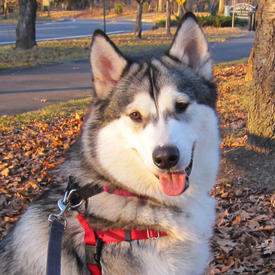Tell me about runner's knee

DontThinkJustRun
Posts: 248 Member
I think I gave myself runner's knee by not replacing my insoles soon enough. That was a few months ago and I just replaced them last week. I didn't know any better. It seems to be maybe improving, not sure yet. At first it was both knees, but more so in the left, then only the right and now only the left again. It doesn't hurt when I run, but after running, during squats and some poses in yoga. Stairs suck too. Alieve and Advil does seem to help.
So I'm training right now and am notorious for not resting, I know I know. I ran through a pretty bad sprained ankle earlier this year which took forever to heal and still has limited range of motion. But it also didn't hurt when I ran so I was just careful and went with it.
I plan on taking it easy for about a month after I'm done training in August, and then gearing up to do a FM in March. But my question I guess is just what others have experienced with runner's knee, how to prevent it, how to ease the damage once you have it and how serious is it? If it's only mild discomfort am I making a big mistake by running through it?
So I'm training right now and am notorious for not resting, I know I know. I ran through a pretty bad sprained ankle earlier this year which took forever to heal and still has limited range of motion. But it also didn't hurt when I ran so I was just careful and went with it.
I plan on taking it easy for about a month after I'm done training in August, and then gearing up to do a FM in March. But my question I guess is just what others have experienced with runner's knee, how to prevent it, how to ease the damage once you have it and how serious is it? If it's only mild discomfort am I making a big mistake by running through it?
0
Replies
-
I'd like more information about this too. I'm no runner, but I've got a bad right knee.0
-
Get some GOOOOOOOD running shoes! Check runners world website for some shoes picked by runners. Make sure you dont overdo it - its easy to do that when you are running. I have been running for 3 months now and I eased into it slowly. I did not want any injuries...
Just be careful!!!0 -
I'm dealing with this right now myself. I ignored it and kept running but I did ice it after runs and use Motrin. Finally it swelled up and I couldn't bend my knee very far so I went in. Now I'm in physical therapy. They are letting me run which is great, but I have to go in three times a week for a while. They said it was because my quads and gluteus medies (side of your butt) were not strong enough to deal with the running I was doing. It made my kneecap track improperly. It's getting better pretty quickly. Still icing and using motrin after running though.0
-
bump0
-
I don't know anything about runners knee, however I feel your pain with the sore knees. I go Friday for an MRI on my left knee because the doctor thinks I have torn my meniscus. If the pain is not going away you should prob see a doctor because what they think I have can not heal on its own it has to be repaired.
My only advice ice, ice, ice! Good Luck and I hope everything works out for you.0 -
I just read a pretty good article on active.com about common running injuries. Go there and check it out. For knee pain, it can really depend on where you feel the pain in your knee. Is it in your knee cap or deeper? If it is in your knee cap, it is easier to work with. Deeper pain can mean bigger problems that you should probably go see your doctor about. I have been having problems with my knees for about a year now. One thing that I have found that really helps is a knee band. It is smaller than those big braces that go above and below the knee and doesn't get all hot and sweaty either (well not as much).
I am lucky that there is a good running shoe company here in town that will evaluate your walk and guide you into the type of shoes you should be wearing. Check out your local sporting goods stores to see if they do something similar.0 -
I've had ACL reconstructive surgery on both knees and make a habit of icing for 15 minutes after any type of exercise. It reduces swelling and I notice a difference in pain immediately. I recently went to a knee specialist because of additional swelling in one knee and he recommended a higher dose of Advil or IBuprofen (3 every 4 hours for 2 weeks and then slowly reduce back to normal doses - although I'm 5'2" and 117 lbs so please talk to a physician about a dosage that is appropriate for you). I immediately noticed reduced swelling and pain and now only take pain relievers after a long run or extensive cardio with a lot of jumping.
If pain continues I'd go see a doc.0 -
How often are you supposed to replace your insoles?0
-
2 things..make sure it is runner's knee...check runners world as said above, and maybe your dr. Good shoes, replace them every 500-600 miles!! And if you pronate get shoes for pronation support.
make sure your hips are not out of alignment. Go to a DO or Chrio and have it checked. If they are out of alignment make sure, because pain presented in knee/ankle doesn't always mean knee ankle is the issue. I use a foam roller to roll on for my IT band and hams, quads and calves. I see a massuse every 3-4 weeks to make sure a tight mussle isn't pulling anything out either.0 -
bump0
-
My shoes are great, but that is great advice for any runner. I use asic kayanos and am on my 3rd pair, I think. It took me a while to find "the shoe" for me. But I got fitted and once I did that I found my love. I can get a brand new pair and go out that day and knock out 10 miles with no break in time.
I'm pretty confindent it's due to not changing out my insoles when the pain first started. I have high arches and pronate. My insoles were well over a year old when the pain started. So running 20+mpw on old insoles for probably did me in.0 -
urgent BUMP!0
-
How often are you supposed to replace your insoles?
On average, running shoes are only good for 300-500 miles. How much wear you personally get out of your shoes depends on many factors--your running style, the surfaces on which you run, your overall weight, etc. The shoes will LOOK fine for a lot longer than that, but the midsole-the part with the cushioning-will have degraded by 300-500 miles. So it's best to log your miles somewhere so you kno wwhen it's becoming time to buy new shoes. If you're in doubt about whether it's time, wear your old running shoes to the store, try on a new pair, and jog around the store. If the new shoes feel at all springier than your old ones, it's time!0 -
Shoes yes, 300-500 miles. Aftermarket insoles - probably a year if they are the really hard ones for support, much less if they are just soft cushion ones.0
-
What is 'runner's knee'? Do you have a specific injury or point of pain?
Here are a few problems that runners often develop that can create knee pain:
-Poor stretching or no stretching. Running will make certain muscles, tendons and ligaments very tight, especially if it's your primary exercise, and you will eventually pull joints out of alignment if you aren't careful and diligent about maintaining flexibility.
-Lack of strength training. Running to the exclusion of most other exercise will produce fairly significant strength imbalances in your legs and hips. Again, this eventually puts unnecessary stress on the joints and makes them move in unnatural ways. Your strength training should include exercises that balance the strength of opposing muscle groups in your legs and hips.
-Running on cambered roads. when you run on cambered roads, one leg is always more extended than the other and running on an angle. It only gets worse on corners. If you must run on cambered roads, change direction frequently to balance the stress on your joints and muscles.0 -
I did a lot of reading yesterday about this same thing and Im thinking it might be something about either how I rotate my knees inward when cycling..or this, which be resolved through squats, stretches, steps, etc.They said it was because my quads and gluteus medies (side of your butt) were not strong enough to deal with the running I was doing. It made my kneecap track improperly.0
-
How often are you supposed to replace your insoles?
On average, running shoes are only good for 300-500 miles. How much wear you personally get out of your shoes depends on many factors--your running style, the surfaces on which you run, your overall weight, etc. The shoes will LOOK fine for a lot longer than that, but the midsole-the part with the cushioning-will have degraded by 300-500 miles. So it's best to log your miles somewhere so you kno wwhen it's becoming time to buy new shoes. If you're in doubt about whether it's time, wear your old running shoes to the store, try on a new pair, and jog around the store. If the new shoes feel at all springier than your old ones, it's time!
Thank you. I should do this, its been about 400 miles. I was not aware than changing insoles was necessary.0 -
How often are you supposed to replace your insoles?
On average, running shoes are only good for 300-500 miles. How much wear you personally get out of your shoes depends on many factors--your running style, the surfaces on which you run, your overall weight, etc. The shoes will LOOK fine for a lot longer than that, but the midsole-the part with the cushioning-will have degraded by 300-500 miles. So it's best to log your miles somewhere so you kno wwhen it's becoming time to buy new shoes. If you're in doubt about whether it's time, wear your old running shoes to the store, try on a new pair, and jog around the store. If the new shoes feel at all springier than your old ones, it's time!
Thank you. I should do this, its been about 400 miles. I was not aware than changing insoles was necessary.
I believe that the OP is talking about custom orthotic insoles, not the insoles that came with the shoes. You shouldn't need to change the ones that came in the shoes. 0
0 -
bump0
-
Prior to anything else, check your form. Try running on some grass barefoot - record it on video if you can. There's only one way your body will let you run barefoot - any other way will be painful. Now record yourself running in your shoes. Compare the two. Knee problems often point to heel striking, instead of striking with the mid/ball of your foot. Striking with your heel = straight knee. A straight knee doesn't absorb shock - it crushes the cartiledge between your bones.0
-
Some good info already.
My thoughts....
Something is thrown off in your form. Might be something you don;'t even know you are doing. Might be a hip/back issue. I don;t have concrete proof, but I was dealing with some mild runners knee issues during marathon training. I also had some really minor lower back/hip alignment issues. Got adjusted and the knee pain went away instantly.0 -
The recommendation above to replace shoes every 500 miles is a good one. That is the ENTIRE shoe, not just the insole. If you need orthotics for pronation, go to a podiatrist--preferably one experienced in dealing with runners.
I'm pretty confindent it's due to not changing out my insoles when the pain first started. I have high arches and pronate. My insoles were well over a year old when the pain started. So running 20+mpw on old insoles for probably did me in.
Runners Knee is also called Chondromalacia Patella. It is a rubbing away of the cartilage under the knee cap caused when the knee cap does not move correctly in the groove in the the bones. This is usually caused by a functional problem like pronation or supination, which affects the motion and position of your entire body. Think about it: If your ankle collapses in every time your foot falls, it puts pressure on your ankle, the muscles in your calves and shins, your knees, hips and low back.
Get orthotics, get fitted for running shoes with soles that are stiffer on the problem side (instep). Work on strengthening the muscles around your ankles. Notice when you walk that you are pronating, and concentrate on not letting your ankle "cave in".
IF you have runner's knee, the pain will worsen as you run and you will not be able to run through it. If you can run through it, the cause is likely something else. Consult with a sports medicine orthopedist.
Disclaimer: not a physician. But my information is based on my own personal experience with runner's knee.0 -
Bump again, this forum moves so fast!0
This discussion has been closed.
Categories
- All Categories
- 1.4M Health, Wellness and Goals
- 395K Introduce Yourself
- 44K Getting Started
- 260.6K Health and Weight Loss
- 176.2K Food and Nutrition
- 47.5K Recipes
- 232.7K Fitness and Exercise
- 445 Sleep, Mindfulness and Overall Wellness
- 6.5K Goal: Maintaining Weight
- 8.6K Goal: Gaining Weight and Body Building
- 153.2K Motivation and Support
- 8.2K Challenges
- 1.3K Debate Club
- 96.4K Chit-Chat
- 2.5K Fun and Games
- 4.2K MyFitnessPal Information
- 16 News and Announcements
- 1.3K Feature Suggestions and Ideas
- 2.9K MyFitnessPal Tech Support Questions














